After researching and writing about physical fitness tests for military and law enforcement agencies over the past 10 years, I began to recognize that the 1.5-mile run, push-up test and sit-up test are nearly universally used as a basis for testing fitness levels. The groups who use this "Common PFT" as a minimum standard for physical testing are the Navy, Air Force, Coast Guard and more than 50% of federal, state and local police agencies.
In military units, they also have alternate testing exercises (such as the bike or swim) if an injury prevents a member from running, and both military and law enforcement units alter the amount of time for push-ups and sit-ups. Some have one-minute tests, and others have two-minute tests for the strength-testing portion. The Coast Guard and some police departments get creative and substitute push-ups with a bench press endurance test, but more than half of the U.S. military and law enforcement agencies use what I call the "Common PFT."
Preparing for this PFT is not that difficult. Most service members can train for a few weeks and score passing grades; the minimum standards are not that difficult. Achieving the minimum standards on anything should not be the peak of our endeavors, no matter what we do personally, but there are many jobs in the military and law enforcement that do not require rigorous physical activity.
However, if your job puts you in harm's way, you should reconsider your fitness level. Whether you are saving yourself, another victim or your partner, having enough strength, endurance and flexibility can make a difference between life and death. Yes, fitness is that important.
While the regular military and law enforcement agencies use the Common PFT as a standard for fitness, the specialized groups in these units -- like SWAT teams, firefighters, Navy SEAL, Air Force PJs and Coast Guard rescue swimmers -- have more rigorous standards and testing exercises. The above units and other special ops groups require differing levels of fitness because of the extreme conditions and missions for which they must be prepared. Many articles and workout programs for the advanced special operations groups above can be found at the Stew Smith article archive and the Fitness eBook store.
The good news about the "Common PFT" is that I have written plenty of articles over the past few years to assist with performing better on the test. Scoring better on physical fitness tests can affect promotion rate, pay grade and energy levels (due to better overall health), as well as your ability to protect and defend yourself and others in an emergency.
Here are several articles to assist you for the next PFT cycle:
- Push-ups and Sit-ups
- The Push-Up Push Workout
- The Proper Technique for Curl-ups
- Take 2:00 Off Your PFT Mile
- Running
- Physical Fitness Test Anxiety
- Get Ready for the Tape Test
- One Month From PFT - Help!
More law enforcement fitness articles:
Training for the Police Academy
All Law Enforcement Fitness Articles
Good luck with your training.
Stew Smith is a former Navy SEAL and fitness author certified as a Strength and Conditioning Specialist (CSCS) with the National Strength and Conditioning Association. Visit his Fitness eBook store if you're looking to start a workout program to create a healthy lifestyle. Send your fitness questions to stew@stewsmith.com.
Want to Learn More About Military Life?
Whether you're thinking of joining the military, looking for fitness and basic training tips, or keeping up with military life and benefits, Military.com has you covered. Subscribe to Military.com to have military news, updates and resources delivered directly to your inbox.



















